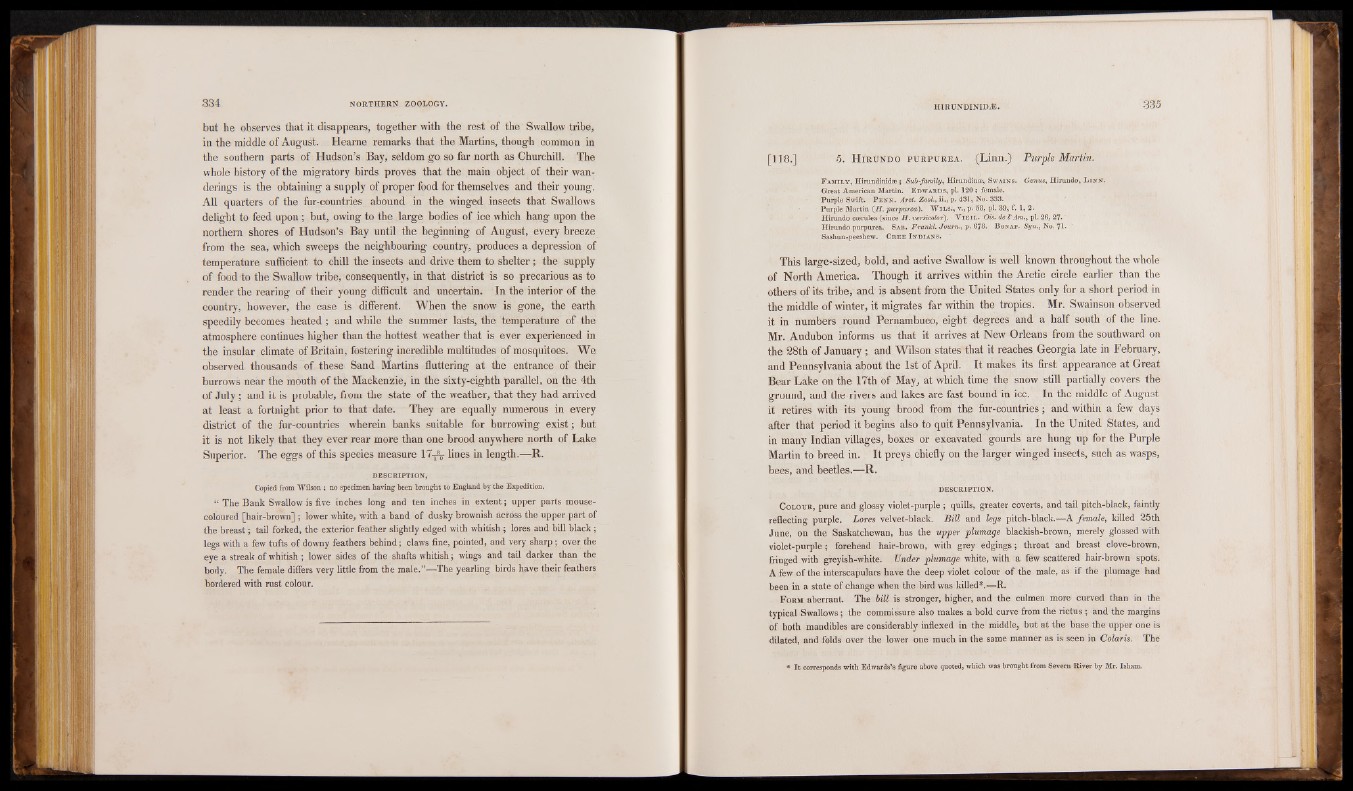
but he observes that it disappears, together with the rest of the Swallow tribe,
in the middle of August. Hearne remarks that the Martins, though common in
the southern parts of Hudson’s Bay, seldom go so far north as Churchill. The
whole history of the migratory birds proves that the main object of their wanderings
is the obtaining a supply of proper food for themselves and their young.
All quarters of the fur-countries abound in the winged insects that Swallows
delight to feed upon; but, owing to the large bodies of ice which hang upon the
northern shores of Hudson’s Bay until the beginning of August, every breeze
from the sea, which sweeps the neighbouring country, produces a depression of
temperature sufficient to chill the insects and drive them to shelter; the supply
of food to the Swallow tribe, consequently, in that district is so precarious as to
render the rearing of their young difficult and uncertain. In the interior of the
country, however, the case is different. When the snow is gone, the earth
speedily becomes heated; and while the summer la'sts, the temperature of the
atmosphere continues higher than the hottest weather that is ever experienced in
the insular climate of Britain, fostering incredible multitudes of mosquitoes. We
observed thousands of these Sand Martins fluttering at the entrance of their
burrows near the mouth of the Mackenzie, in the sixty-eighth parallel, on the 4th
of July; and it is probable, from the state of the weather, that they had arrived
at least a fortnight prior to that date. They are equally numerous in every
district of the fur-countries wherein banks suitable for burrowing exist; but
it is not likely that they ever rear more than one brood anywhere north of Lake
Superior. The eggs of this species measure 17TaT lines in length.—R.
DESCRIPTION,
Copied from Wilson ; no specimen having been brought to England by the Expedition.
“ The Bank Swallow is five inches long and ten inches in extent; upper parts mouse-
coloured [hair-brown] ; lower white, with a band of dusky brownish across the upper part of
the breast; tail forked, the exterior feather slightly edged with whitish; lores and bill black ;
legs with a few tufts of downy feathers behind; claws fine, pointed, and very sharp; over the
eye a streak of whitish; lower sides of the shafts whitish; wings and tail darker than the
body. The female differs very little from the male.”—The yearling birds have their feathers
bordered with rust colour.
[118.] 5. H irundo purpurea. (Linn.) Purple Martin.
F a m il y , Hirundinidse ; Sub-family, Hirundinse, Sw ain s. Genus, Hirundo, L in n .
Great American Martin. E dwards, pi. 120 ; female.
Purple Swift. P e n n . Arct. Zool., ii., p. 431, No. 333.
• ■ Purple Martin (H. purpurea). W il s .-, v., p. 58, pi. 39, f. 1, 2.
Hirundo ccerulea (since H. versicolor). V i e i l . Ois. de 1' Am., pl. 26, 27*'
Hirundo purpurea. Sab. Frankl. Journ., p. 678. B onap. Syn., No. 71-
Sashun-peesbew. Cuee I n d ia n s.
This large-sized, bold, and active Swallow is well known throughout the whole
of North America. Though it arrives within the Arctic circle earlier than the
others of its tribe, and is absent from the United States only for a short period in
the middle of winter, it migrates far within the tropics. Mr. Swainson observed
it in numbers round Pernambuco, eight degrees and a half south of the line.
Mr. Audubon informs us that it arrives at New Orleans from the southward on
the 28th of January; and Wilson states that it reaches Georgia late in February,
and Pennsylvania about the 1st of April. It makes its first appearance at Great
Bear Lake on the 17th of May, at which time the snow still partially covers the
ground, and the rivers and lakes are fast bound in ice. In the middle of August
it retires with its young brood from the fur-countries; and within a few days
after that period it begins also to quit Pennsylvania. In the United States, and
in many Indian villages, boxes or excavated gourds are hung up for the Purple
Martin to breed in. It preys chiefly on the larger winged insects, such as wasps,
bees, and beetles.—R.
DESCRIPTION.
Colour, pure and glossy violet-purple ; quills, greater coverts, and tail pitch-black, faintly
reflecting purple. Lores velvet-black. Bill and legs pitch-black.—A female, killed 25th
June, on the Saskatchewan, has the upper plumage blackish-brown, merely glossed with
violet-purple; forehead hair-brown, with grey edgings; throat and breast clove-brown,
fringed with greyish-white. Under plumage white, with a few scattered hair-brown spots.
A few of the interscapulars have the deep violet colour of the male, as if the plumage had
been in a state of change when the bird was killed*.—R.
Form aberrant The bill is stronger, higher, and the culmen more curved than in the
typical Swallows; the commissure also makes a bold curve from the rictus ; and the margins
of both mandibles are considerably indexed in the middle, but at the base the upper one is
dilated, and folds over the lower one much in the same manner as is seen in Colaris. The
* It corresponds with Edwards’s figure above quoted, which was brought from Severn River by Mr. Isham.